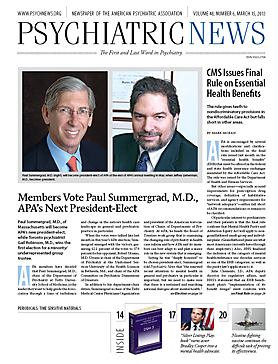APA is encouraged by several modifications and clarifications included in the final rule issued last month on the “essential health benefits” (EHB) that must be offered in the federal and state health insurance exchanges mandated by the Affordable Care Act. The rule was issued by the Department of Health and Human Services.
But other areas—especially around requirements for prescription drug coverage, definition of habilitative services, and agency requirements for “network adequacy”—either fall short of APA recommendations or remain to be clarified.
Of particular interest to psychiatrists and their patients is that the final rule confirms that Mental Health Parity and Addiction Equity Act will apply to nongrandfathered small-group and individual plans. (Grandfathered plans are what most Americans currently have through their employers.) Also, HHS finalized the inclusion of the category of mental health/substance use disorder services as one of the EHB categories, as well as the parity law’s application to it.
Julie Clements, J.D., APA deputy director for regulatory affairs, said HHS’s statement that an EHB benchmark plan’s “implementation of its benefit design” must conform with nondiscrimination provisions in the Affordable Care Act gives these provisions extra teeth that could be of assistance to patients who later experience violations of the parity law.
Also on the plus side, the final rule makes explicit that an issuer’s benefit design, or the implementation of its benefit design, may not discriminate based on an individual’s age, expected length of life, present or predicted disability, degree of medical dependency, quality of life, or other health conditions.
Additionally, in instances in which a state’s benchmark plan lacks a mental health/substance use disorder services category, HHS requires the state to supplement this category with services from another HHS-approved benchmark plan type. HHS clarifies this supplementation can occur at no additional cost to the state.
All states have by now selected a “benchmark plan” type from among four HHS-approved plan types. The state’s benchmark plan comprises the state’s essential health benefits, plus whatever state benefit mandates that state had on its books by December 2011. The plan types have to include 10 health service categories, and if the plan type selected by a state—say, a small-group employer plan—lacks one of these categories, it has to take a category from another HHS-approved plan type, perhaps a Medicaid HMO plan or a plan from the Federal Employees Health Benefits Program (FEHBP), and supplement its benchmark plan type. As an example, Arkansas, selected a small-group employer plan, which is an HHS-approved type, but it lacked mental health service coverage. This meant Arkansas had to supplement the mental health service category with one from another HHS-approved plan type—in this case, an FEHBP plan.
Clements said APA, along with other groups, had lobbied for EHB benchmark plans to include a better floor for prescription drug coverage. In particular, APA had asked HHS to require EHB benchmark plans to abide by the Medicare Part D prescription drug “all or substantially all” standard, which requires plans to include six classes of prescription drugs.
But HHS is retaining its current requirement that an EHB’s prescription drug category be composed of the greater of one drug per class or what is currently covered in a given state’s prescription drug category for its EHB benchmark plan. However, HHS does provide an appeals process for seeking coverage of a “clinically appropriate” drug not covered by the EHB benchmark plan. HHS states in the final rule that it will release further regulatory guidance to describe this appeals process.
APA had also encouraged HHS to define habilitative services using either the National Association of Insurance Commissioners (NAIC) definition or the Medicaid program definition. In the final rule, HHS allows states to determine which habilitative benefits must be covered by their EHB benchmark plan, and they may choose to use the NAIC or Medicaid definition of habilitative services. Where states choose not to define habilitative services, individual insurance issuers may define habilitative services, but HHS will require that issuers define them so they are in parity with what is included in the given state’s benchmark plan’s rehabilitative services category.
Finally, APA had requested that HHS include in its final rule guidance on “network adequacy,” referring to the type and scope of providers included in physician networks. In the final rule, HHS chose not to address network adequacy, stating that compliance with network adequacy standards is outside the scope of the final rule.
APA hopes the subject of network adequacy will be addressed in future ACA or parity act regulatory guidance. ■
